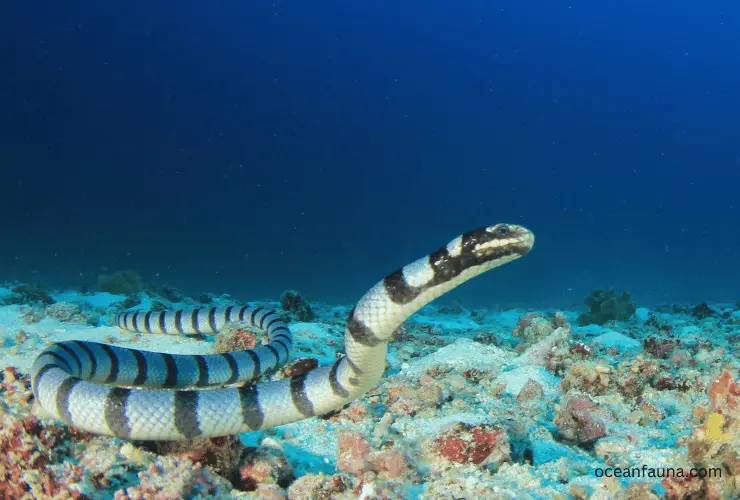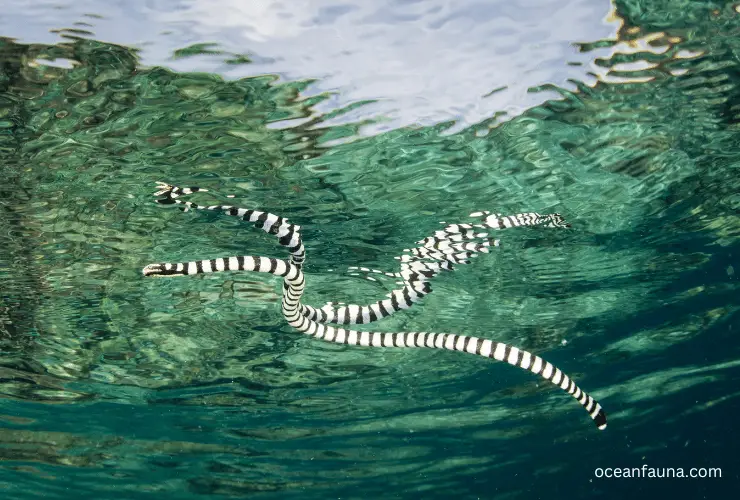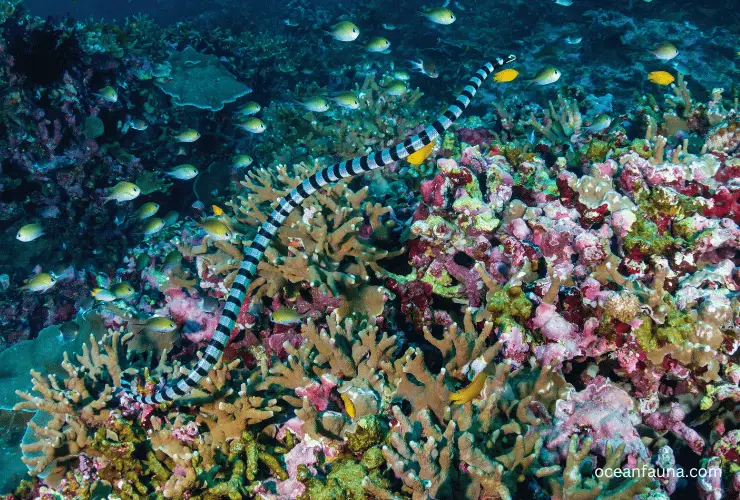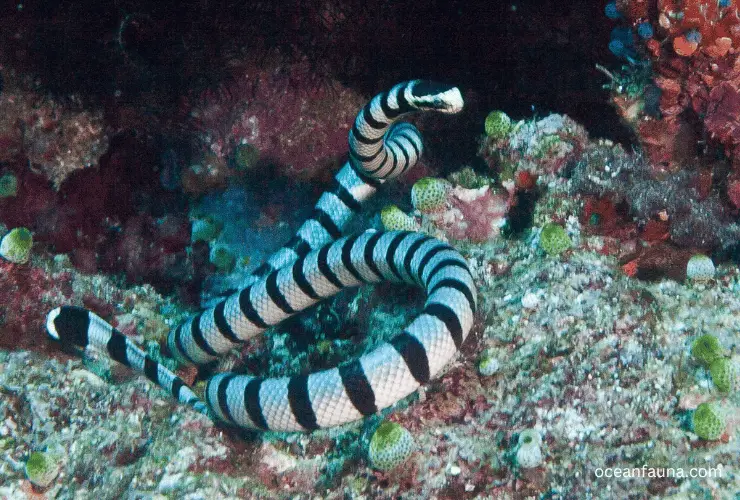Hate snakes? Fear snakes? Try hating black-banded sea kraits because they are one of the most venomous snakes on earth. In the family Elapidae, the black-banded sea krait (Laticauda semifasciata) is a member of the subfamily Laticaudinae. It’s an astonishing sea krait that’s now one of the most worth-considering snakes in the world.
Probably, one of your country’s provincial, national, or even national parks hold several of the black-banded sea kraits. Considering that you’re there, it’s best not to approach them as they’re venomous. Their toxins are so powerful, the health of a person bitten by a black-banded sea krait is irreversible.
You ought to know a lot more facts and figures about black-banded sea kraits because they’re very ferocious, intelligent, and adaptable snakes. That’s why this article is merely dedicated to answering all of your questions related to black-banded sea kraits. Let’s read on to find out more.
Black-Banded Sea Krait: Facts and Features
Kingdom: Animalia
Phylum: Chordata
Class: Reptilia
Order: Squamata
Suborder: Serpentes
Family: Elapidae
Genus: Laticauda
Species: L. semifasciata
Scientific name: Laticauda semifasciata
Synonyms:
- Platurus semifasciatus
— Reinwardt in Schlegel, 1837
- Platurus fasciatus var. semifasciatus
— Fischer, 1856
- Laticauda semifasciata
— Stejneger, 1907
- Pseudo Laticauda semifasciata
— Kharin, 2005
- Laticauda semifasciata
— Rasmussen et al., 2011
Conservation Status: Near Threatened (IUCN 3.1)
Length: 170 cm
Population size: Unknown
Discussion About the Habits and Lifestyle Of Black-Banded Sea Krait
Black-banded Sea kraits are rarely seen because they’re strictly solitary and fierce snakes. They are not usually found in waters, as they prefer large deep-sea areas with plenty of clear patches.
Let’s discuss some of its other habits and lifestyle in the following sections.
1. Appearance
This savage sea snake is about the length of a human (4 to 6 feet) when fully grown, and as with all native Asian pitvipers, they’re known for having black bands running around the mouth and the whole body.
This doesn’t sound terrifying, but the venom of this particular species of sea snake is so potent. Its head is small in comparison to its thick trunk and there is no clear neck.
There are no bony outgrowths from the spinal column that support the tail, so it is merely an extension of skin that is spread wide like a fin. It has a large and comparatively wide stomach.
2. Habitat and Lifestyle
The black-banded sea snake is nocturnal. This species is rarely seen during daylight hours. It needs to come up for air at least once every six hours.
Despite their high level of aquaticity, they frequently emerge from the water during the breeding season or simply to relax and digest food. They change their habits and lifestyles according to their needs.
However, black-banded sea kraits are not adaptative to seasonal behavior. They do not migrate from their places. Their lifestyle is semiaquatic, terratial, and predator.
These sea snakes come ashore to lay their eggs, just like sea turtles, saltwater crocodiles, and other reptiles do. They also occasionally drink freshwater, and for that, they must seek out coastal sources of water.
Additionally, they frequently eat, sleep, and shed their skin on land while using pebbles. They can hold their breath for a longer period to hunt prey. Their living habits are quite similar to other sea kraits.
3. Diet and Nutrition
Black-banded Sea kraits are eels and fish lovers. Isn’t it silly? It doesn’t mean they love to fish; it means they love to eat eels and fish. In other words, they are piscivores or carnivores. Their speed is slow while hunting fish.
Because of its slow speed, it must instead search for elusive fish among the coral. The black-banded sea krait, on the other hand, can be found in hundreds. How?
They do this by hunting alliances with bluefin trevally to flush potential prey from tight crevices in a reef, much like some moray eels. Their bite is so toxic that it paralyzes their prey.

Zoological studies indicate that the black-banded sea krait primarily eats fish. More than 200 snakes were captured and killed so that experts could examine them and determine what they had been eating. They discovered that just roughly 70 snakes, or one-third of them, had anything in their stomachs.
4. Development
Due to the resistive nature of black-banded sea kraits towards climatic changes, it’s difficult for the snakelets to survive in harsh environments. However, they reach their maturity level after a few months of birth.
The snout-vent lengths (SVL) of males and females of the black-banded sea krait are 70 and 80 cm (28 and 31 in), respectively, when sexual maturity is reached. L. semifasciata can grow to a total length of 170 cm, including the tail (67 in).
5. Mating Habits
Black-banded Sea kraits typically swarm together close to the coast during the breeding season. These sea snakes have an internal fertilization process of reproduction. Females frequently lay their eggs collectively in caves and amid tiny fissures in the reef.
Typically, clutches have 3 to 7 eggs, which hatch after 4-5 months. The Black-banded Sea krait’s snout-vent lengths are 70 and 80 cm (28 and 31 in), respectively, when males and females reach reproductive maturity. Their incubation period is 4-5 months.
6. Location
Asia and Oceania are the continents where black-banded sea kraits live. Southeast Asia and East Asia are the favorite subcontinents of these sea beasts.
And more specifically, if we talk about countries, then China, Indonesia, Japan, the Philippines, and Taiwan are the locations where you can easily be encountered with a black-banded sea krait.
Throughout the western Pacific Ocean, it inhabits warmer regions. Moreover, these sea kraits are inhabitants of coral reefs. They hide them there to hunt and get their prey easily.
They love to live in tropical marine environmental areas. Thus, their biome is specific to the intertidal zone, the neritic zone, coastal and marine ecosystems.
However, PLoS One reports that they may be expanding their range as a result of climate change. Twelve of these snakes were discovered by the study’s researchers off the coast of South Korea. (Source)
When their genetic background was examined, it was discovered that they originated close to the Ryukyu Islands, a collection of southern Japanese islands.
It is believed that they were transported northward by the current and that ocean warming allowed them to continue existing and reproducing farther north.
7. Population
The black-banded sea kraits are stated as Near Threatened (NT) from the research given on the site IUCN (International Union for Conservation of Nature). What does it mean? (Source)
A species is considered to be near threatened if it has been given the designation “Near Threatened” (NT) by the International Union for Conservation of Nature, even though it does not yet meet the criteria for the threatened status.
What are the reasons behind this status? Why are they near extinguishing? Climate change is the main reason behind this. It can lead it toward a massive decrease in its prey abundance.
The refuge sites would also be lost. Thus, climate change is the most important reason behind its near to threatened status. It affects its population and diet.
Adaptation of the Black-Banded Sea Krait
Thanks to their numerous adaptations that enable them to survive both on land and in the sea. They can move on land and climb low-hanging tree branches because of their large belly scales, which resemble those of land snakes.
They also have the ability to excrete extra salt received from the marine environment due to a salt gland under the tongue. Nasal valves and tightly fitting scales around the mouth serve as seals to prevent ingestion of water while they are submerged in water. Propulsion is provided by paddle-shaped tails.
They can stay under the water for extended periods, ranging from an average of 15 to 30 minutes to almost two hours, thanks to lung volumes that are proportionately considerably higher than those of their land-based ancestors. Black-banded Sea kraits are well adapted to hunt in the coral reefs.
What Are the Other Names of Black-Banded Sea Krait?
These snakes have many names. The names of the black-banded sea krait vary depending on where they are in the world. Their names are present in different languages all over the world.
One of the common names of black-banded sea kraits is Chinese sea snake, Chinese sea snake, and erabu. It’s known as irabu in Okinawa and erabu umi hebi in Japan.
Its scientific name is Laticauda semifasciata. Semifasciata is the Latin word for “half striped,” while Laticauda is a Greek word for “wide or broad tail.”
What Are the Predators Of Black-Banded Sea Krait?
Although there aren’t many predators, they nonetheless face dangers and harm. Masked palm civets may try to attack the females when they go onto land to lay their eggs.
According to the research of the Oceana organization, “Sea birds, sharks, and some bony fishes are the biggest and hungry predators of black banded sea kraits. They feed on these reptiles and hunt to meet their dietary needs.” (Source)
They will run away, hide, stay calm, or swim away when a predator approaches. They blend in with the background of the ocean floor due to their coloring and fuzzy patterns. A few predators also mistakenly view their tails as their heads.
Discuss The Behavior of Black-Banded Sea Krait with Humans
According to National Geographic, sea kraits are known for being very aggressive snakes, but they tend to avoid people when they encounter each other. Most people are not aggressive toward them, but this is one time when they would attack anyone that comes close.
Oceana organization has stated detailed research about the relationship and behavior of black banded sea kraits with humans in the following words:
“The banded sea krait rarely interacts with humans, and scientists think there is little to no threat to the species extinction. Banded sea kraits are occasionally caught in nets or traps intended for other animals, and if they are imprisoned for an extended period of time, they risk drowning.
However, it appears that these encounters don’t happen very often. Even though banded sea kraits have strong venom, an urban legend holds that their lips are too small for a person to be bitten.
Contrary to popular belief, banded sea kraits appear to be calm snakes that frequently decide not to bite, even when provoked. However, some people get bitten every year (most notably fishermen who accidentally capture them).” (Source)
Their venom is a mix of different toxins, and it works by paralyzing the victims with it. When it comes to venomous snakes, these sea snakes can cause intense pain and eventually lead to death. But they only bite the humans when they feel insecure, threatened, or provoked.
According to the Encyclopedia of Britannica, sea kraits are one of the most poisonous snakes around. Its poisonous bite is ten times more dangerous and stronger than cobra. People should not panic, but they should be cautious and watch out when they encounter them. (Source)
Is Black-Banded Sea Krait Venomous?
Yes, the black-banded sea krait is a venomous species of sea kraits or sea snakes. Compared to a king cobra, their venom is more toxic. They dwell out at sea, so we don’t hear much about them because we seldom ever run into them.

By putting the venom of black-banded sea kraits through laboratory tests, researchers have determined how dangerous they are. The black-banded sea krait’s results range from 0.11 mg/kg to 0.2 mg/kg.
These findings show you would require between 6.82mg and 12.4mg to kill a person, given that the average adult weighs 62 kg. The quantity needed to kill 50 out of 100 test subjects—known as the “median lethal dose,” or LD50—was determined using a test.
The amount of venom required to kill an animal is expressed in milligrams per kilogram of body weight, or mg/kg. Therefore, if the required amount was 1 mg/kg, it would take 8 mg to kill an 8-kilogram animal.
Numerous factors contribute to the variance in outcomes across research. The required amount will vary if you inject it into muscle tissue, the bloodstream, or just below the skin. Additionally, certain species can withstand poison better than others. (Source)
How Venomous Is the Black-Banded Sea Krait?
Black-banded Sea kraits can kill a human with their poison and they are fast when they move, so they are the ones that usually bite most. Most bites happen when the animals are younger and unsuspecting, as they are mostly found on tropical beaches.
The Aquarium of Pacific Organization has clearly answered how venomous are the black-banded sea kraits:
“The sea krait’s venom severely affects both muscles and nerves. It is ten times more toxic than a rattlesnake’s bite. Venom from each snake can weigh up to 10-15 mg (0.0004-0.0005 oz). A lethal dose can be produced in very small quantities which can easily kill a man or any other animal on the planet.” (source)
What Are the Symptoms Of Black-Banded Sea Krait Bite?
The most common symptoms of black banded sea kraits include the following:
- Abdominal pain
- Headaches
- Body aches and muscle aches
- Poor reflexes
- Pain, fatigue, and weak muscles
- Enlarged lymph nodes
- Anxiety, drowsiness, and confusion
- Blurred vision
- Breathing difficulties; labored breathing
- Feeling faint or dizzy
- Blue-colored skin due to poisoning
- Unconsciousness
- Convulsions
- Paralysis
- Cardiac failure
- Sudden death
- Muscle weakness and breakdown
- Seizures
Their venom has myotoxic and neurotoxic effects. This indicates that it targets both the muscles and the neurological system. Venom from snakes and lizards contains myotoxins, which rapidly degrade muscle mass.
If enough venom is used, it instantly paralyzes the target. Blocking the lungs from breathing results in death. The nervous system is attacked by neurotoxins.
It essentially coats the receptors, making it impossible for the brain and body to connect. This has the same result as mycotoxins in that it prevents the heart and lungs from pumping blood.
Is There Any Antivenom for the Bite of a Black-Banded Sea Krait?
No. There is no specific antivenom for the bite of a black-banded sea krait. However, scientists believe that “Antivenin Polyvalent Sea Snake” is the best and most widely available antivenom for sea snake bites. However, contacting the toxicology expert is the best solution.

The cornerstone of black-banded sea krait’s bite treatment is a prompt injection of the proper antivenom (or antivenin). In addition, symptomatic management is required, which may entail painkillers, fluids, and respiratory assistance. With prompt and efficient treatment, the prognosis of a Black Banded Sea Krait Bite is typically good.
Amazing Facts of Black-banded Sea Krait
Here are a few amazing and fascinating fun facts given by the organization of Oceana that will increase your curiosity about knowing more about this marine reptile: (source)
- Black-banded Sea kraits, which are much smaller than the eels they consume, swallow their prey completely before returning to land to digest it, which could take many weeks.
- Female, black-banded sea kraits can weigh up to three times more than male sea kraits. They are much heavier than the males. They often consume bigger conger eels, whereas males prefer moray eels, which are smaller.
- Male black banded sea kraits are only 30 inches (75 cm) long, compared to the 50 inches (128 cm) of females.
- Black-banded Sea kraits can submerge themselves for a period of 15 to 30 minutes on average before coming back to the surface to breathe.
- One-fifth of the sea krait’s entire oxygen requirements are thought to be absorbed by its skin, which also completely eliminates all of the carbon dioxides the snake creates.
FAQs
Are black-banded sea kraits friendly?
No, black-banded sea kraits are not friendly. Fishermen have called them very ductile. They are beautiful and gentle while crawling and swimming. But it doesn’t mean they are humans friendly.
Where does the black-banded sea krait live?
The black-banded sea krait mostly lives in eastern India and the western Pacific oceans. They live in both seas and lands.
Can black-banded sea krait kill you?
Yeah, black-banded sea krait can easily kill you with its dangerous venom. Its bite contains ten times more dangerous venom for killing an average-sized social animal.
Are black-banded sea kraits poisonous?
Yes, black-banded sea kraits are poisonous. Their venom is called the most toxic venom in the world. It can cause sudden death.
How dangerous are black-banded sea kraits?
Black-banded Sea kraits are so dangerous that they have been called one of the most lethal creatures on this globe. They have short, fixed fangs for biting the prey. Their targeted prey becomes paralyzed, and they swallow them for a whole. The venom of an adult snake can easily kill ten humans at a time.
Can a sea snake bite you under the water?
Yes, a sea snake can bite you under the water. But they only bite if they are feeling threatened. Researchers examined 100 patients who visited a nearby hospital with sea snake bites for the Tropical Journal of Medicine and Hygiene. Over 80% of the patients were fishermen who had been in the sea, they discovered.
Conclusion
Black-banded Sea kraits are amazingly vicious creatures, and they must be treated with extreme precaution. Contact with them can result in severe pain, severe bleeding, and, ultimately, death.
I hope this Black Banded Sea Krait article is informative enough to help you learn more about this venomous sea snake and that you are forewarned that if you ever find one of them around, you should stay away from them.

